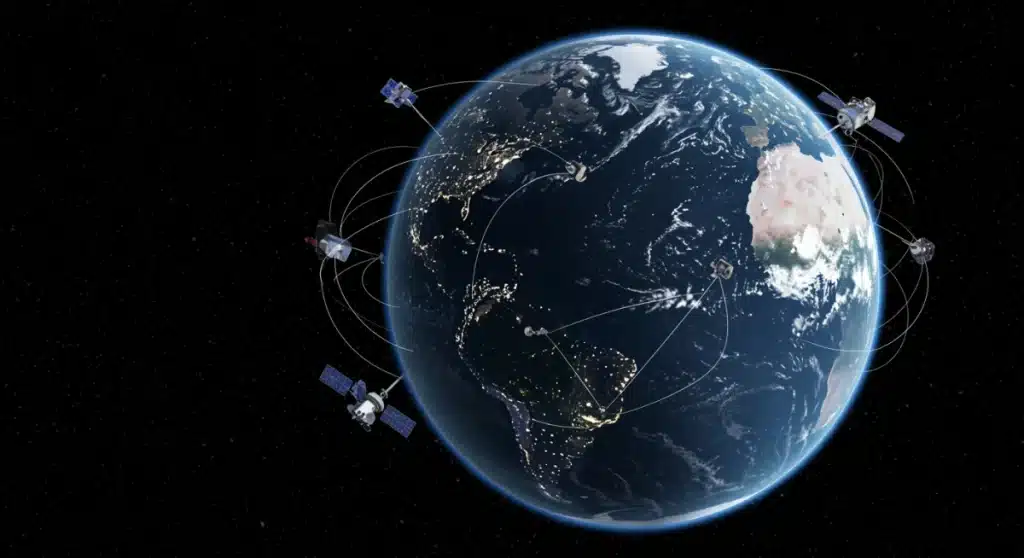2025 Satellite Internet: US Global Operations Analysis

A 2025 performance analysis reveals that satellite internet providers are profoundly enhancing US global operations by delivering unprecedented connectivity, crucial for military, diplomatic, and commercial endeavors worldwide.
Satellite Internet Providers: A 2025 Performance Analysis for US Global Operations (COMPARISON/ANALYSIS) reveals a rapidly evolving landscape. As of early 2025, the demand for robust, ubiquitous global connectivity has never been higher, driven by geopolitical shifts, expanding digital economies, and the increasing reliance on real-time data across all sectors. How are the leading providers stacking up?
The Evolving Landscape of Satellite Internet in 2025
The year 2025 marks a pivotal moment for satellite internet, with significant advancements redefining global connectivity. The deployment of next-generation low Earth orbit (LEO) constellations has dramatically altered performance metrics, offering speeds and latencies previously unattainable. This evolution is particularly crucial for US global operations, where reliable communication in remote or underserved areas is paramount.
Traditional geostationary orbit (GEO) providers continue to play a role, especially for stable, high-bandwidth applications, but LEO systems are increasingly favored for their low latency and expanding coverage. This shift impacts everything from military communications to disaster response and remote business operations.
LEO Constellations: A Game Changer
LEO constellations, such as Starlink and OneWeb, are at the forefront of this transformation. Their proximity to Earth drastically reduces signal travel time, leading to significantly lower latency compared to GEO satellites. This makes them ideal for applications requiring quick response times.
- Reduced Latency: Essential for real-time data, video conferencing, and critical command and control.
- Global Coverage: Designed to provide internet access even in the most isolated regions, including polar areas.
- Increased Throughput: Higher bandwidth capabilities support data-intensive operations and multiple users simultaneously.
Starlink’s Dominance in Global Reach
Starlink, operated by SpaceX, continues to be a dominant force in the 2025 Satellite Internet Analysis. Its extensive constellation of LEO satellites provides unparalleled global coverage, making it a go-to solution for US operations in areas lacking traditional infrastructure. Recent upgrades to its ground stations and satellite technology have further boosted its performance metrics.
The provider’s ability to offer high-speed internet in challenging environments has made it indispensable for military, humanitarian, and commercial deployments. Its rapid deployment capabilities and ease of setup are key advantages in dynamic operational scenarios.
Performance Metrics and User Experience
As of early 2025, Starlink consistently delivers download speeds averaging 150-250 Mbps, with peak speeds often exceeding 300 Mbps in optimal conditions. Latency typically ranges from 20-40 ms, a significant improvement over traditional GEO satellite services. This performance profile supports a wide array of demanding applications.
- Average Download Speed: 150-250 Mbps, suitable for most operational needs.
- Typical Latency: 20-40 ms, enabling near real-time interactions.
- Reliability: Improved uptime due to a larger, more resilient constellation and advanced beamforming.
OneWeb’s Enterprise and Government Focus
OneWeb has solidified its position as a key player, particularly in the enterprise and government sectors. Unlike Starlink’s consumer-first approach, OneWeb has strategically focused on providing connectivity solutions for businesses, governments, and telecommunication providers. This targeted strategy has allowed them to tailor their services to specific, high-demand operational requirements.
Their ongoing constellation deployment, now nearing completion, ensures robust and consistent service levels across vast geographical areas. OneWeb’s partnerships with established telecom companies further expand its reach and integration into existing networks, offering a strong alternative for US global operations.
Strategic Partnerships and Service Offerings
OneWeb’s collaborations with major telecommunications entities and defense contractors are central to its strategy. These partnerships facilitate seamless integration of satellite connectivity into complex operational frameworks, providing secure and scalable solutions. Their service is characterized by a commitment to quality of service (QoS) and service level agreements (SLAs).
- High-Capacity Backhaul: Ideal for connecting remote bases and data centers.
- Secure Communications: Tailored for sensitive government and defense applications.
- Global Footprint: Comprehensive coverage for multinational operations.

Viasat and HughesNet: GEO Satellite Resilience
While LEO constellations capture much of the headlines, GEO satellite providers like Viasat and HughesNet continue to be critical for certain US global operations. These providers offer established infrastructure and a proven track record, particularly for fixed-site deployments requiring consistent, high-bandwidth connections, even if at higher latency. Their resilience in adverse weather conditions and mature technology stacks offer distinct advantages.
Viasat, with its high-capacity satellites, provides robust services for commercial aviation, maritime, and specific government applications. HughesNet, while often associated with consumer broadband, also offers enterprise solutions that are vital for areas where LEO coverage might still be developing or cost-prohibitive for specific use cases.
Advantages and Niche Applications
GEO satellites excel in delivering large volumes of data to specific, fixed locations. Their broad coverage footprint from a single satellite makes them efficient for broadcasting and certain backhaul services. While latency remains a drawback for real-time interactive applications, their reliability for data transfer and video streaming is well-established.
- High Throughput: Capable of delivering significant bandwidth for data-intensive tasks.
- Established Infrastructure: Proven technology with extensive ground segment support.
- Cost-Effectiveness: Can be more economical for long-term, fixed deployments.
Emerging Technologies and Future Outlook
The 2025 Satellite Internet Analysis would be incomplete without examining emerging technologies poised to shape the future. Beyond LEO and GEO, medium Earth orbit (MEO) constellations are gaining traction, promising a balance of lower latency than GEO and broader coverage than some LEO systems for specific applications. Developments in optical inter-satellite links and advanced antenna technologies are also enhancing overall network capabilities.
Furthermore, the integration of artificial intelligence (AI) for network management and dynamic resource allocation is becoming standard practice, optimizing performance and ensuring efficient use of satellite capacity. This constant innovation drives the industry forward, providing increasingly sophisticated options for US global operations.
Key Technological Innovations
Several innovations are converging to refine satellite internet services. These advancements are not just incremental improvements; they represent fundamental shifts in how satellite networks operate and deliver value.
- Optical Inter-Satellite Links: Enable faster data transfer between satellites, reducing reliance on ground stations.
- Phased Array Antennas: Offer dynamic beam steering and multi-user capability, improving efficiency and flexibility.
- AI-Powered Network Management: Optimizes traffic routing, predicts outages, and enhances security.
Impact on US Global Operations and Security
The enhanced capabilities of Satellite Internet Providers: A 2025 Performance Analysis for US Global Operations (COMPARISON/ANALYSIS) directly translate into significant advantages for US global operations and national security. From enabling real-time intelligence gathering to supporting remote diplomatic missions and providing critical communication for disaster relief, satellite internet is a foundational element of modern global engagement.
The ability to establish secure, high-bandwidth connections anywhere on Earth provides a strategic edge, allowing for rapid deployment of resources, effective command and control, and seamless coordination across diverse agencies and international partners. This connectivity also bolsters economic interests by facilitating global commerce and digital diplomacy.
Strategic Advantages and Challenges
While the benefits are clear, challenges remain, including cybersecurity threats, spectrum management, and the need for resilient ground infrastructure. However, ongoing collaboration between government, military, and private sector providers is addressing these issues, ensuring the continued evolution and security of these vital networks.
- Enhanced Situational Awareness: Real-time data from remote locations informs critical decisions.
- Operational Flexibility: Rapid deployment of communication infrastructure in crisis zones.
- Cybersecurity Concerns: Requires robust encryption and threat detection systems to protect sensitive data.
| Key Point | Brief Description |
|---|---|
| LEO Dominance | Low Earth Orbit constellations like Starlink and OneWeb are leading in speed and low latency. |
| Provider Specialization | Starlink focuses on broad global reach, while OneWeb targets enterprise and government solutions. |
| GEO Resilience | Viasat and HughesNet remain crucial for fixed, high-bandwidth applications despite higher latency. |
| Emerging Tech | MEO constellations, optical links, and AI are further enhancing satellite internet capabilities. |
Frequently Asked Questions About 2025 Satellite Internet
LEO (Low Earth Orbit) satellites, like Starlink, offer significantly lower latency (20-40ms) due to their closer proximity to Earth, making them ideal for real-time applications. GEO (Geostationary Earth Orbit) satellites, such as Viasat, provide broader, more stable coverage but with higher latency (500-700ms), suitable for fixed, high-bandwidth data transfers.
Starlink’s extensive global coverage and high-speed, low-latency connectivity are revolutionizing US military and intelligence operations by enabling real-time data transfer, enhanced situational awareness, and reliable communication in remote or contested environments, providing crucial tactical advantages and operational flexibility.
OneWeb focuses on providing robust, high-capacity connectivity solutions for governments and large enterprises. Its LEO constellation offers secure, reliable internet for critical infrastructure, backhaul for remote bases, and maritime/aviation sectors, often through strategic partnerships with established telecommunication providers, ensuring tailored service level agreements.
Yes, increased reliance on satellite internet introduces cybersecurity risks, including potential vulnerabilities in ground stations, satellite links, and user terminals. Providers and operators are implementing advanced encryption, zero-trust architectures, and continuous threat monitoring to safeguard sensitive data and maintain network integrity against sophisticated cyber threats.
Emerging technologies like Medium Earth Orbit (MEO) constellations, optical inter-satellite links, and AI-driven network management are set to significantly enhance satellite internet. MEO offers a balance of latency and coverage, optical links boost data transfer speeds between satellites, and AI optimizes network efficiency and resilience, pushing performance boundaries.
What Happens Next
The trajectory of 2025 Satellite Internet Analysis indicates continued rapid innovation and deployment. We anticipate further consolidation among providers and increasing integration of satellite services with terrestrial networks. Regulatory frameworks will likely evolve to address spectrum allocation, orbital debris, and international cooperation challenges. The ongoing race for supremacy in low Earth orbit will continue to drive down costs and improve service quality, making satellite internet an even more indispensable tool for US global operations and the broader interconnected world.





